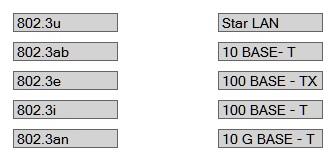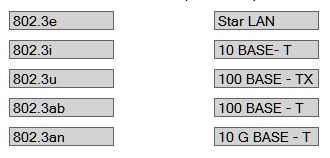Description: This lab exercise helps you to learn the Base-T Ethernet standards and their descriptions.
Instructions:
1. Drag and drop the Base-T Ethernet standards to their respective names.

Solution :
The correct answer is displayed on the left

Explanation :
The 100Base-T standard is made up of 3 versions:
100BASE-TX is full-duplex capable in point to point unshared applications because it uses 1 pair to receive and 1 pair to transmit. Designed to run over 2 pairs of category 5 unshielded twisted pair cable with RJ45 connectors and EIA/TIA 568B pinning. It can also be run on IBM type 1 shielded twisted pair (existing Token Ring wiring) with an impedance matching device and DB9 connectors or regular STP and DB9 connectors. Max segment length is 100m.
100BASE-T4 designed to run over 4 pairs of category 3, 4 or 5 UTP cable with RJ45 connectors and EIA/TIA 568B pinning. It can also be run over STP. 1 pair is used to receive while 3 pairs are used to transmit, However full-duplex operation does NOT work because specific pairs are not designated to transmit or receive. Max segment length is 100m.
100BASE-FX designed to run over 2 strands of duplex multimode fiber optic cable. It's also fullduplex capable because it uses one strand for receive and one for transmit. Maximum cable segment varies depending on the cabling used. Singlemode (depending on the manufacturer) can exceed 10 km when fullduplex.
Multimode maximum length is 412 meters for half-duplex and 2 km ful-duplex. Max length from station to repeater is 150 meters.
NOTE: For full-duplex operation on 100BASE -TX or FX:
1) Devices must support full-duplex
2) Connection must be unshared end to end.